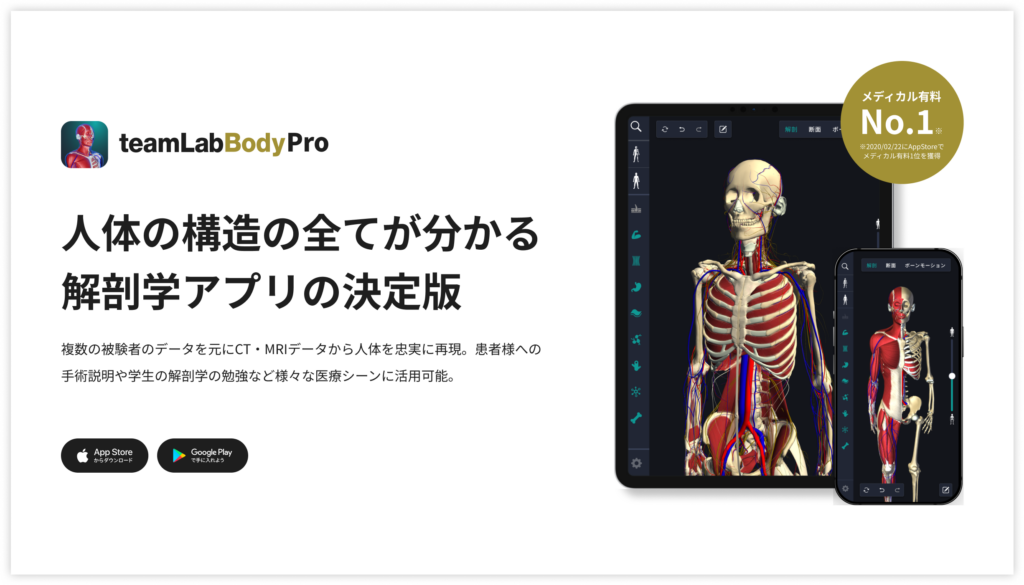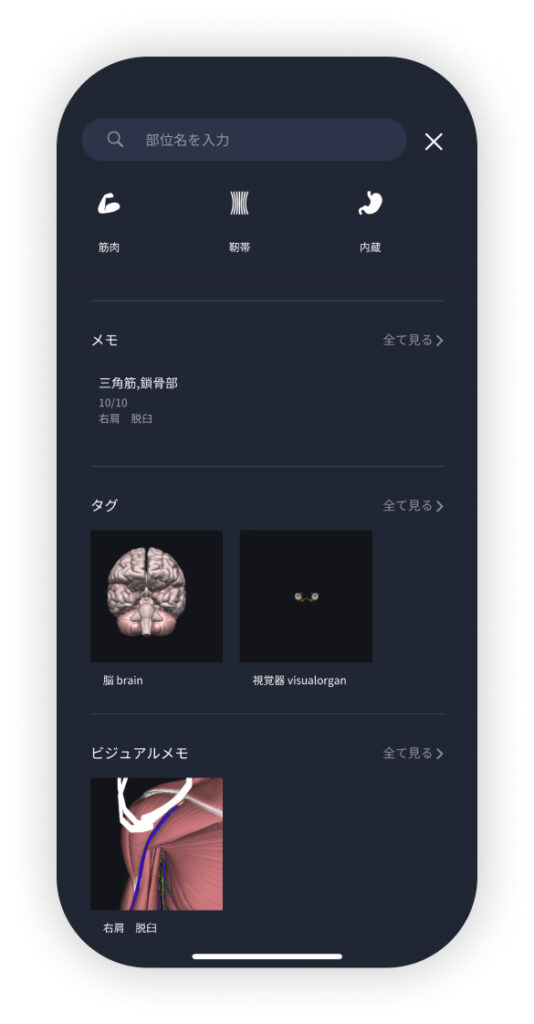beginning
In this article, I will explain effective study methods, starting with knowledge of specialized parts in human anatomy.
In human anatomy, it is necessary not only to memorize the names of various organs, muscles, and bones, but also to remember where they are located in the body. Therefore, it is necessary to learn as efficiently as possible.
I hope you will deepen your understanding even a little by reading this article and using the app.
Now, I'll explain the details about “ciliary muscle” and how to study human anatomy.
teamLab Body Pro Free Download
A 3D anatomy app that shows all the structures of the human body
Download teamLab Body Pro here!

What is ciliary muscle?
The anatomy application allows you to view a selection of anatomy 3D models. In this model, there are various observation methods such as surfaces, cross-sections, and nervous systems. This time, I'll explain using an anatomy application.
About ciliary muscle

Ciliaris muscle (Ciliaris muscle) exists in the eyemedial eye muscleIt is one of the important muscles that adjusts focus (adjusts) by adjusting the thickness of the lens. This lineInside the ciliary processIt is located and contracted under the control of the parasympathetic nerve (derived from the oculomotor nerve).
When contracted, the tension applied to the chin frenulum (ciliary frenulum) loosens, and the lens becomes round due to elasticity. As a result, it's easier to focus on nearby objects. Conversely, when muscles relax, the lens stretches, and the focus is on the distance. This is the mechanism for “perspective focus adjustment.”
As the flexibility of these muscles decreases with aging, the mobility of the lens also declines and presbyopia (presbyopia) occurs. Understanding the ciliary muscle is very important not only in ophthalmology, but also in considering connections with the whole body, such as innervation and the autonomic nervous system.
Study points
Anatomical understanding: understanding location and structure
The ciliary muscle is particularly inside the eyeballA structure that continues to the outer edge of the iris called the ciliary bodyIt exists inside. Visually capturing positional relationships with other elements that make up the eyeball (cornea, lens, iris, vitreous) is the first step in learning. If you check how the ciliary muscle is connected to the lens and ciliary frenulum using a cross-sectional view or 3D eyeball model, you can make a more three-dimensional image.
Also, pay attention to innervation. Ciliary muscle is controlled by the parasympathetic nervous system (oculomotor nerve → ciliary ganglion → short ciliary nerve), and this pathway is extremely important clinical knowledge.
Functional understanding: experience the mechanism of focus adjustment
The biggest role of ciliary muscle is the regulatory effect for “seeing closely.” If you look far away after looking at a smartphone, it's blurry; this is evidence that the ciliary muscle is transitioning from a contracted state to a relaxed state. like this,Consciously observe visual adjustments that occur naturally in everyday lifeBy doing this, you can feel the function of the ciliary muscle.
Furthermore, decreased regulation due to aging (presbyopia) and eye fatigue due to impaired regulation are also related to the function of ciliary muscles. Coupled with these changes, it's easier to understand the importance of features.
Practical application: learning the connection to clinical symptoms
What is ciliary muscle learningClinical ophthalmology perspectivesIt's also very important. For example, in “regulatory paralysis (cycloplegia),” activity in this muscle is suppressed, and the ability to see close is reduced. Also, eye drops (atropine, etc.) may temporarily block the function of this muscle and perform accurate refractive measurements.
Furthermore, since nerve paralysis and autonomic disorder affect the ciliary muscle, focus adjustment may not work well. By learning this clinical background, you can deeply understand the meaning not just as a structure, but as an “object of examination and treatment.”
How to study human anatomy
I will explain specific study methods using human anatomy applications.
Check your past learning history and practice repeatedly
Here are the steps to check your anatomy learning history and practice iteratively effectively.
1. Check your learning history in the app
Reviewing your learning history with the application is an important step in effectively advancing anatomy learning. First, launch the app and go to the learning history section from the main menu. Many anatomy apps are designed to show your progress in the form of graphs and lists, so you can visually check which parts you've learned about and how much time you've spent.
By using this data, you can understand which areas you have strengths in and where you need to spend more time and effort. We also recommend using a dedicated tag or notebook function to mark areas you are particularly weak at or where you need to relearn. Regularly checking your learning history and looking back on past learning content will lead to efficient review and deepening understanding.
2.Make a plan for iterative learning
Making an efficient repetitive learning plan based on learning history is extremely effective in promoting knowledge retention. First, identify weak points and areas where you need to relearn. Next, arrange these study items into a weekly or monthly calendar and create a specific study schedule. By proceeding in a planned manner, you can learn each part evenly and avoid packing in a large amount of information at once.
Using a task management app or digital calendar to set study reminders is effective. Also, it's important to have the flexibility to regularly review progress and revise plans as needed. By having goals and proceeding with your studies in a planned manner, you can efficiently acquire anatomical knowledge.
3.Use 3D features to learn visually
By utilizing the 3D function, learning anatomy is easier to understand visually. The 3D model shows the structure of the human body three-dimensionally, and each part can be observed in detail. This makes it possible to intuitively grasp positional relationships between deep muscles and organs that are difficult to capture in a planar view. For example, you can learn even the smallest details by rotating specific muscles and bones and zooming in and out.
Also, there are many apps that have the function of displaying cross-sectional views of each part using a 3D model, which is useful for deepening understanding of internal structures. This diversity of visual information helps with memory retention and improves immediate responsiveness in tests and practice situations. By utilizing the 3D function and learning visually, you can learn anatomy knowledge more deeply and efficiently.
Use the memo function concretely

Make notes so you don't forget the things and points you've noticed while studying. The memo function can be used for different purposes, such as inputting text, saving images, and writing memos. Tag your notes to make them easier to review later.
Test your learning regularly in the form of quizzes
Regularly testing what you've learned in a quiz format is a very effective way to anchor your anatomy knowledge. Quiz-style tests help you objectively grasp your level of understanding and areas you lack while repeating knowledge.
For example, by using a learning app to conduct quizzes every specific period, you can reconfirm what you've learned and strengthen your memory. There are a wide range of quiz formats, such as multiple choice questions, fill-in-the-blank questions, and short answer questions, and each helps understanding from a different angle and develops the ability to utilize various types of knowledge.
Get feedback
If possible, get feedback from other learners and experts. It helps you find your own gaps in understanding and areas for improvement. You can also keep yourself motivated to learn by regularly testing yourself. Feeling a sense of accomplishment and progress increases motivation for continuous learning.
summary
This time, I explained how to study “ciliary muscle” using an application!
Thank you for reading this far.
I would be happy if reading this article helped you learn about anatomy.
Learning is a long, never-ending journey, but I sincerely wish you all the best. Let's continue to study together and work hard for the national exam!
Please look forward to the next blog.
teamLab Body Pro Free Download
A 3D anatomy app that shows all the structures of the human body
Download teamLab Body Pro here!





